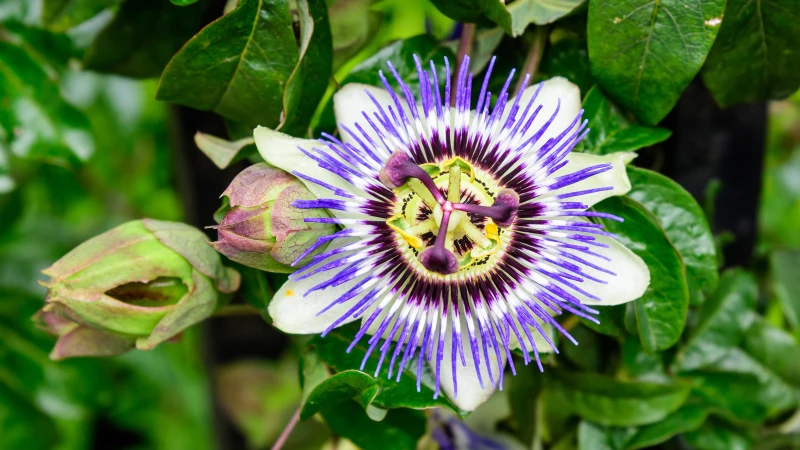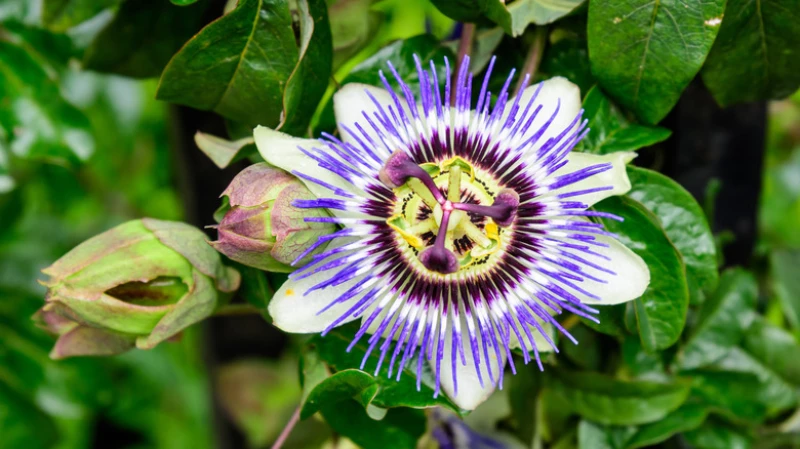Passionflowers: A Colorful and Intricate Plant Family
Passionflowers (Passiflora spp.) are a diverse group of plants with over 550 species, known for their vibrant blooms and intricate structures. Originating from Central and South America as well as Southeast Asia, these plants range from vines and lianas to shrubs and trees. Some passionflowers bear edible fruits, while others are prized for their ornamental foliage and stunning flowers. While these perennials can attract hummingbirds and butterflies with their colorful blooms, they are also prone to various pests and diseases. To keep your passionflowers healthy, it's essential to regularly check for signs of infestations, identify symptoms of diseases, and ensure they receive proper care.
Among the popular passionflower species are the bluecrown passionflower (P. caerulea), purple passionflower (P. incarta), and passionfruit vine (P. edulis), famous for its delicious fruit. These plants feature deep green leaves that come in a variety of shapes, from ovate to deeply lobed. The flowers of passionflowers are a complex display of radial petals surrounding a central crown of filaments, available in shades of purple, white, blue, red, and yellow.
Passionflower vines require proper care to thrive and avoid common diseases. When grown outdoors, these plants can be vulnerable to cucumber mosaic virus (CMV), which manifests as yellow mottling on the leaves. Aphids are the primary carriers of CMV, so it's essential to remove them using water, soapy spray, or insecticides. Weeds like chickweed and groundsel can also harbor the virus, so ensure to eliminate them from the planting site. Another threat to passionflowers is Fusarium wilt, a fungal disease that causes pale foliage and wilting. Avoid planting passionflowers in areas previously affected by Fusarium wilt or opt for a resistant variety like P. cincinnata.
Additionally, caterpillars and spider mites can damage passionflower vines. Caterpillars, especially the gulf fritillary species, feed on the leaves and stems. Handpicking them is an effective control method for small populations. In greenhouse cultivation, watch out for spider mites, which can be identified by delicate silk webs on the foliage and flower buds. Regularly inspect your plants and use lukewarm water or horticultural oil to manage these pests. To prevent the spread of diseases, practice good gardening habits like cleaning tools, inspecting plants, and properly disposing of infected material.
Passionflowers thrive in subtropical and tropical regions, with some species adaptable to cooler climates. P. caerulea can flourish in zones 6a to 10b, while P. incarta is suited for zones 7b to 11. For P. edulis, it's recommended to grow in hardiness zones of 9b and above, whereas the most resilient passionflower vine, P. lutea, can withstand down to zone 5a. In colder climates, passionflower vines shed their leaves during winter, while in warmer regions, they remain evergreen throughout the year.
To cultivate passionflowers successfully, select a sheltered spot with full to partial sunlight. These climbing plants use axillary tendrils for support, so consider structures like trellises, arbors, or garden fences to showcase them in your garden. Passionflowers are vigorous growers, so regular pruning is essential to prevent overgrowth and maintain a neat appearance. Prune once a year in spring, cutting back up to half of the year's growth if necessary. Plant your passionflower vines in well-draining soil and water outdoor plants weekly during dry spells to preserve moisture. For potted passionflowers, water when the top layer of soil is dry.








